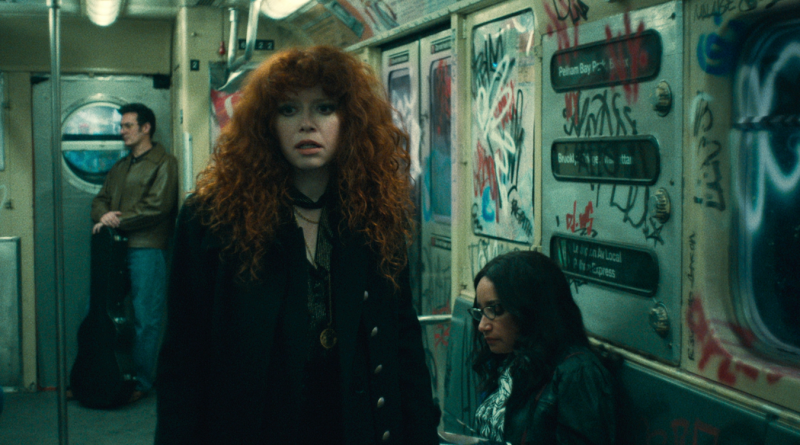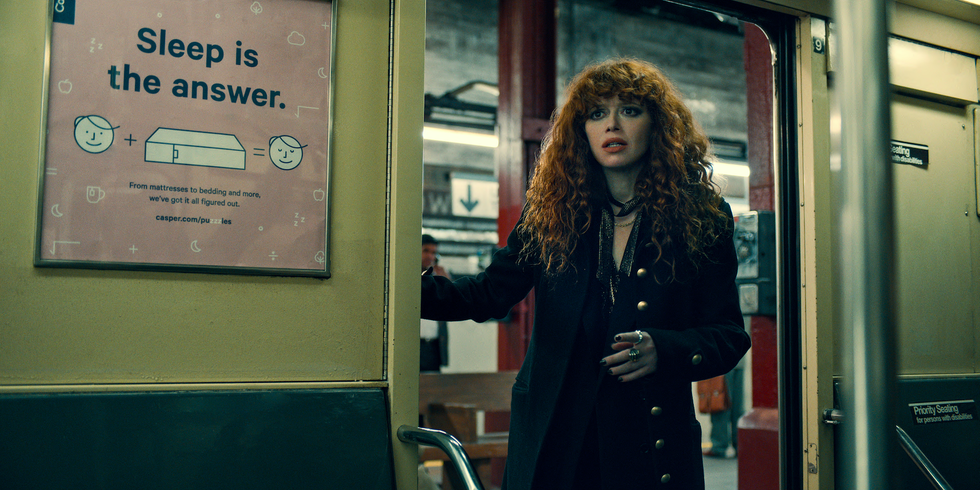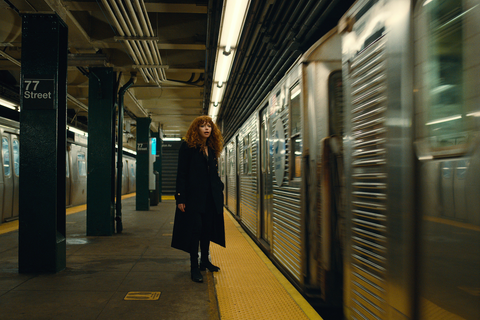Like Its Second Season, the Fashion in Russian Doll Is Built To Last
Timeless fashion takes on new meaning in the second season of Russian Doll, which sees Nadia Vulvokov (Natasha Lyonne) travel back into her heart-rending family history. Three years have passed since we watched Nadia celebrate her 36th birthday party on a Groundhog Day-esque loop, and in season 2, her impending 40th sets her on another collision course. And though Russian Doll’s universe has a new mind-bending adventure in store for Nadia and Alan (Charlie Barnett), one thing remains constant from the Netflix drama’s first season: the intrepid New Yorker’s fuss-free and enviable aesthetic.
“We’re starting with a character who has a very strong identity, sartorially,” Emmy Award-winning costume designer Jenn Rogien told ELLE.com before the debut of season 2. “She basically wears a uniform: her black jeans, her blazer, a great coat, a beautiful blouse, her low heeled boot. It’s a signature for her.” In the first season, Rogien conceived a literal birthday suit that would stand up to the rigorous demands of a time-loop narrative; many multiples of each garment were required. In the sophomore chapter, similar masculine-meets-feminine tailoring is utilized once more to combine Nadia’s hardened edge and the softer elements bubbling beneath the surface in her quest to right family wrongs.
Three years have passed since we last saw Nadia and while the critical reaction is similarly high to the first outing, the online response has been more muted so far. Perhaps it will be a slow burn—there are a lot of TV shows premiering this month—as the series retains its bold essence that made audiences first sit up and take notice. Russian Doll mixes a high concept with grounded execution, and the costume design plays into the latter. Nadia’s sartorial direction is striking without requiring flashy gimmicks. In a world falling apart, it remains a source of dependability.
“It’s about the alchemy of finding those pieces that really speak to and for character that make sense and feel real,” Rogien says about sourcing garments from high-end and affordable brands. Similarly, the garments worn in the 1980s scenes by Chloë Sevigny (as Nadia’s mother, Nora) are predominantly vintage to match the era. No doubt, Nadia’s signature look will inspire viewers to embrace future-proof tie-neck blouses, double-breasted blazers, and gold jewelry—all without having to embark on a time-bending adventure. Below, Rogien tells us about Nadia’s season 2 wardrobe, how it highlights the series’ mission as a whole, and where copycat shoppers should look for similar pieces.
A Signature Outfit
Nadia’s jeans, blouse, and jacket uniform is “a coat of armor in addition to being her signature look,” Rogien says, so she didn’t want to tweak too many elements. Still, she wanted to convey the years of experience the character has acquired since her time loop in season 1. “It was more about staying within the character identity visually, and incorporating some new pieces that suited the action and the emotion of this second season,” Rogien says. Some repeats from the first year do make an appearance, including Nadia’s go-to Gap high-rise skinny jeans: Rogien’s team pulled a full rack of new jeans for season 2 but “couldn’t top” the original style. “They were just the right thing,” Rogien describes. “Which will make it an even larger challenge should there be a season 3 and we need to find new jeans.” For season 2, there were thankfully plenty of pairs left over from the first chapter, which the costume team then tailored and redyed to achieve the proper saturation.
Paired with her Lonely black bra and a double-breasted blazer, the jeans look is finished off with Nadia’s Rodarte for Cole Haan black ankle boots, which came straight from Lyonne’s personal wardrobe. Rogien says Lyonne told her no other boots would do, reportedly saying, “‘These are the boots. I know I can walk in these for 14 hours a day.’” Unfortunately, Rogien could only track down a solitary pair on eBay that were a half size bigger than Lyonne’s, so the actress mainly wore the ones she brought from home.
Shoes don’t always get a lot of screentime, but the camera lingers on Nadia’s footwear throughout season 2, emphasizing their workmanship and timeless quality as she strides through New York City and beyond. Boots that are built to last are vital for Nadia’s mission and Lyonne’s long working days. “When I say that those boots have lived a life!” Rogien says. “You can see it in the wear and tear. I mean they’re incredible, but they looked so beat up.” The lesson Rogien is taking from this? “Don’t do a show about multiples with two pairs of boots.”
Hearts on Her Sleeves
In the first three episodes, Nadia sports a tie-neck Hobbs London blouse with an eye-catching gold lurex mini-thread shot through the black chiffon fabric. “I liked it because the stripe had life in it, and I knew it would bounce light in different scenarios,” Rogien says. “Sometimes it looks olive, sometimes it looks gold, sometimes it looks black.” Limited changes in the first outing were caused by the time loop, but Nadia still only wears three ensembles (there is a fourth in the final scene) to reflect the three defining chapters of the season. With fewer costumes, Rogien considers the multiple scenarios—and time periods—that Nadia will find herself in. “How do I make it interesting to look at for long periods of time?” she recalls asking herself.
Gold plays a significant role in Nadia’s intergenerational trauma, which includes the story of the Krugerrand coins that represent her family’s misfortune. Her mother, Nora, gave her the coin necklace she wears to this day, and this accessory symbolizes both loss and love. Rogien notes the costume version is a repeat of the Donna Sackowitz design from the first season.
In the series, Nadia’s Hungarian grandmother Vera (Irén Borán) is a Holocaust survivor, and so Nadia, the youngest member of the family, travels to Budapest in a bid to alter history. Rogien herself traveled to the European location and the production shot all four time periods here (including some of the East Berlin scenes), “We did a lot of the ‘40s there, we did some ‘60s, we did modern-day, and ‘80s.”
Maxine joins Nadia on this girls’ trip in episode 4 and it marks the first clothing change. Unlike her BFF who has packed multiple outfits (including a dazzling silver leather jacket), Nadia’s baggage is the emotional kind. In an attempt to find out what happened to her family’s heirlooms, she tracks down the great-grandson of the Nazi officer who issued the receipt for their valuables in 1944. Nadia begins at the address where her grandmother lived before catching up with Kristofz (Balázs Czukor) who doesn’t have any answers but does invite the pair to a trippy all-night rager. “I wanted something that would fit this journey—ending up at this crazy party,” Rogien says about Nadia’s red and black tie-neck silk blouse. “A little bit of a pattern to keep a color story going and to visually signify that something else is happening now.”
The red and black visual is a nod to season 1 and the degraded heart Diane von Furstenberg print is not meant to be as “on the nose” as it sounds. “While she goes to find the story of her origins, she is wearing her heart on her sleeve—which sounds so incredibly cheesy when I say that out loud,” describes Rogien. “But the print seemed to suit what was happening in that episode.”
Overcoats as Armor
Nadia bursts onto the screen in the premiere wearing a black military-inspired Avec Les Filles overcoat, which reflects her strong sartorial identity that was established in season 1—and is similar to the Polo Ralph Lauren cashmere coat Nadia wore then. The tailored long design is worn in all but one episode and is big enough so Lyonne can wrap it around herself as extra protection. It also needs to be roomy enough so she can layer this look with a black double-breasted or leather blazer underneath.
Because the accidental time traveler sticks to black jeans and boots, Rogien was mindful once again—particularly during night scenes—that the dark costumes “do not disappear on camera.” Gold is threaded throughout Nadia’s costumes from the precious Krugerrand necklace to the first blouse she wears, and this coat also taps into this theme. “Natasha and I talked a lot about the fact that that coat had gold buttons,” Rogien says about the Avec Les Filles garment that had gold buttons on the front and back—on the cuffs, center back belt, and shoulders. “Yes, it was a great silhouette, had the right shoulder for Nadia, had that topcoat feeling, and some menswear tailoring feeling,” notes Rogien. “But it also had elements that would keep her from disappearing.”
There is a purposeful outerwear change in the fourth episode set in contemporary Budapest when Rogien introduced an olive Theory coat into Nadia’s wardrobe. “It was absolutely referencing the WWII elements that were in that story,” explains Rogien. “She’s handling some unknown circumstances with her family backstory and what really happened. It was to give her an even stronger silhouette as she goes into there.” Nadia then returns to her signature black topcoat for the final three episodes.
No matter the outerwear, it is necessary for plenty of pocket room because carrying a handbag would be “too fussy” for this character. With this in mind, Rogien had to source outerwear that could hold Nadia’s cigarettes, phone, and clues from the past without ruining the line of the coat (her lighter is on a retractable keychain). “Everything goes in her pockets,” she says. “All the blazers have pockets, the coats have pockets, the jeans have pockets—no handbag necessary!”
A Vision from the Past
To everyone that Nadia encounters when journeying through time she either takes on the appearance of her mother Nora (Chloë Sevigny) clad in ‘80s florals or grandmother, but the audience sees her in whatever outfit she is wearing when she gets on the subway. However, it is still necessary to consider how Nadia’s attire fits into these scenarios. “It’s building off of the Nadia uniform to not necessarily draw attention or have it feel anachronistic because her silhouette is not a fashion silhouette,” says Rogien about the intentional choice to make sure Nadia doesn’t look out of place. “It is a fairly pared-down silhouette that doesn’t key into any specific time period trend,” adds the designer.
Nadia’s final look last season when she found a solution to the time loop shenanigans was a white blouse borrowed from Maxine. Now she doesn’t need to grab something from Maxine (who typically embraces current fads) and is “changing it up as she goes.” The white tuxedo front Sandro blouse and black ribbon tie that is worn throughout the final three episodes are from Nadia’s closet. During this portion of the story, Nadia goes back in time to a Nazi-occupied Budapest in 1944, gives birth to herself on the subway platform in 1982, and causes time to fold in on itself when she brings baby Nadia back to the present day. This is a new conundrum to solve and the designer needed “at least six of them around” at all times to deal with the action-heavy final trio of episodes.
“There was a little bit of femininity that we liked when she starts dealing with the idea of kidnapping her own self and grappling with motherhood,” says Rogien about the starkness of this black and white combination in the third chapter. Nadia and Alan are now trapped in a different time loop and “having the colors desaturate” reflects the final chapter of their journey. “White is a very strong silhouette,” she says before nodding to the stunt heavy goose-bump-inducing sequence that required multiples. “That is where I learned you want to have a lot when you use a white blouse for three episodes and [Nadia] falls in the water,” she laughs.
Nadia’s twisty trip into her past throws up plenty of (meta)physical challenges and in each era, Lyonne’s mass of red curls is balanced by the strong lines of this character’s classic New York uniform. Russian Doll is packed with twists and turns, but ultimately its story is grounded in themes that are as evergreen as Nadia’s closet. Time-defying style has never looked better.
This content is created and maintained by a third party, and imported onto this page to help users provide their email addresses. You may be able to find more information about this and similar content at piano.io
























